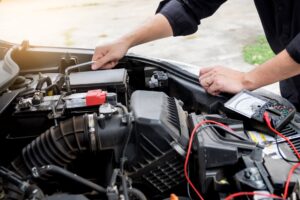
Proper diagnosis of electrical issues is crucial for several reasons. Firstly, it helps in identifying the root cause of the problem, allowing for efficient repairs. Secondly, it prevents further damage to the system and reduces the risk of accidents or breakdowns. Lastly, by diagnosing and addressing issues promptly, you can save time, money, and effort in the long run.
The importance of electrical system diagnostics cannot be overstated, especially when it comes to vehicles. A malfunctioning electrical system can cause performance issues, including poor fuel economy and engine misfires. It can also result in safety hazards such as loss of power steering or failed lighting systems. Similarly, household appliances and industrial machines rely heavily on electrical systems, and a fault in the system can lead to malfunctioning or even complete breakdowns.
Common Electrical Problems
Before delving into the diagnostic process, let’s take a brief look at some common electrical problems that can occur. These issues can affect various systems, such as vehicles, appliances, or electronic devices. Examples include dead batteries, faulty alternators, blown fuses, loose or corroded connections, and wiring problems. Understanding these problems and their symptoms will help us troubleshoot effectively.
Safety Precautions
Working with electricity demands utmost caution. Neglecting safety measures can lead to severe injuries or even fatalities. Therefore, before attempting any electrical diagnostics or repairs, it’s crucial to prioritize safety. This involves wearing appropriate protective gear, such as insulated gloves and goggles, and following best practices, such as turning off power sources before handling electrical components.
Basic Tools for Electrical System Diagnostics
To effectively diagnose electrical problems, you need a few essential tools. One of the most crucial tools is a multimeter, which allows you to measure voltage, current, and resistance. A circuit tester is also valuable for identifying open circuits and shorts. Additionally, wire strippers, crimpers, and connectors are necessary for making repairs. It’s important to familiarize yourself with these tools and understand their functions and proper usage.
Common Electrical Problems and Their Symptoms
In this section, we will explore common electrical problems and the symptoms associated with each. By recognizing these symptoms, you can narrow down the possible causes and proceed with the diagnostic process more efficiently.
Dead Battery
Symptoms of a dead battery include difficulty starting the vehicle, dim headlights, and electrical malfunctions. Possible causes can range from faulty alternators to parasitic drains. Diagnostic steps may involve inspecting the battery’s voltage and performing load tests. Depending on the diagnosis, you can then troubleshoot and repair accordingly.
Faulty Alternator
A faulty alternator can lead to various electrical issues, such as frequent battery drain or flickering lights. To diagnose this problem, you can use a multimeter to test the alternator’s output voltage and check for loose connections. Repairs may involve replacing the alternator or addressing related issues like worn-out belts.
Loose or Corroded Connections
Loose or corroded electrical connections can lead to intermittent power loss or malfunctions. Symptoms may include flickering lights, non-responsive switches, or sporadic device operation. Inspecting connections visually and performing continuity tests with a multimeter can help identify the problem. Repairing loose connections may involve tightening or replacing connectors, while corrosion can be addressed with cleaning solutions.
Wiring Issues
Faulty wiring can result in a range of electrical problems, such as shorts, open circuits, or malfunctioning devices. Symptoms may include sparks, burning smells, or non-functional equipment. Diagnostic steps may involve visually inspecting the wiring for damage or using a multimeter for continuity tests. Repair options can vary from repairing or replacing damaged wiring to re-routing circuits.
Step-by-Step Troubleshooting Process
Now that we have covered common electrical problems and their symptoms, let’s outline a step-by-step troubleshooting process to effectively diagnose and resolve these issues.
- Visual inspection of electrical components: Examine components for visible damage, loose connections, or signs of wear.
- Testing the battery and alternator: Use a multimeter to measure battery voltage, load test the battery, and check the alternator’s output voltage.
- Checking fuses and relays: Inspect and test fuses and relays using a multimeter to ensure they are functioning correctly.
- Inspecting and repairing connections: Verify the tightness and cleanliness of electrical connections and repair or replace as needed.
- Identifying and resolving wiring problems: Inspect wiring for damage, test for continuity, and address any wiring issues detected.
Advanced Diagnostics
While basic tools and techniques can solve many electrical problems, certain cases may require advanced diagnostic tools and equipment. These tools, such as oscilloscopes or scan tools, can provide more in-depth insights into complex electrical systems. Additionally, interpreting diagnostic trouble codes (DTCs) can aid in identifying specific issues and facilitating repairs. It’s important to understand when advanced diagnostics are necessary and seek professional assistance if required.
When facing complex electrical issues, it’s crucial to have access to advanced diagnostic tools and equipment. These powerful tools like oscilloscopes or scan tools can help in identifying the root cause of the problem and provide a more accurate diagnosis. Interpreting diagnostic trouble codes (DTCs) is also valuable when troubleshooting complex systems. However, it’s important to remember that these tools require special expertise and experience to use effectively. If you’re unsure about how to use them or if the problem requires professional assistance, don’t hesitate to seek help from an experienced technician. Your safety and the well-being of your vehicle depend on accurately diagnosing and repairing electrical issues. Trusting the experts can save you time, money, and potential safety hazards down the road. Don’t hesitate to contact a trusted mechanic or electrical specialist for assistance with advanced diagnostics if needed.
Preventive Maintenance Tips
To minimize the occurrence of electrical problems, regular preventive maintenance is essential. Here are a few tips to keep your electrical system in optimal condition:
- Regular inspection and cleaning of electrical components: Remove dirt, debris, and corrosion from connectors, terminals, and other components.
- Checking and tightening connections periodically: Ensure all connections are secure and tight to prevent intermittent power loss.
- Proper battery maintenance: Check the battery’s fluid levels, clean terminals, and replace old batteries when necessary.
- Being aware of electrical system warning signs: Pay attention to unusual smells, sounds, or behavior exhibited by electrical components, as they may indicate underlying issues.
Conclusion
Maintaining the functionality of electrical systems requires proactive troubleshooting and regular maintenance. By understanding common electrical problems, following safety precautions, and utilizing the appropriate tools, you can diagnose and resolve issues effectively. Remember, electrical system diagnostics not only save you time and money but also contribute to the safety and reliability of your devices and vehicles. Stay proactive, and keep your electrical systems running smoothly.
At DT Performance, we understand the importance of a properly functioning electrical system in your vehicle. Our experienced technicians are equipped with advanced diagnostic tools and techniques to identify and address any issues quickly and efficiently. We also offer preventive maintenance services to ensure your electrical system remains in top condition, saving you time, money, and potential safety hazards down the road. Don’t hesitate to contact us for all your electrical system needs. Trust us to keep your vehicle running smoothly and safely.
See Other Related Post

DT Performance is Here to Help – Services We Offer
DT Performance is Here to Help – Services We Offer Are you looking for a reliable and affordable data transmission solution? DT Performance has you

What are the advantages of having anything repaired by a mechanic?
What are the advantages of having anything repaired by a mechanic? The advantages of having anything repaired by a mechanic are many. For one thing,

8 Car Maintenance Tips To Keep Your Car Running Like New
8 Car Maintenance Tips To Keep Your Car Running Like New No one wants to deal with car troubles, but they’re a fact of life.

How to keep your car in top condition?
How to keep your car in top condition? Maintaining your car is essential. You want to keep it in top condition to avoid any costly

Find a Mechanic Near Me: 10 Tips to Choosing the Right One
Find a Mechanic Near Me: 10 Tips to Choosing the Right One https://youtu.be/mL7Fvm9_Y2Q We all know how important it is to have a good Mechanic.

Enhance Your Driving Experience: Engine Performance Upgrades in Darwin, NT
Enhance Your Driving Experience: Engine Performance Upgrades in Darwin, NT Are you tired of driving a sluggish car that lacks power and acceleration? Do you

The Benefits of Choosing a Professional Mechanic
The Benefits of Choosing a Professional Mechanic When it comes time to take your car in for a tune-up, service, or repair, who do you



